Infrared Conversion Questions
Aug 24, 2017 23:18:07 #
larryepage
Loc: North Texas area
I have seen a number of really wonderful IR photos posted here. I've always been fascinated by photography techniques that bring the otherwise invisible to light.
Interestingly enough, I find myself in possession of a Nikon D200 that is perfectly functional except for the flash system and that has lots of life left. I'm looking for a good application for this body. First thought was for a "high risk environment" body, but now I'm wondering whether IR might be a lot more fun.
My initial research has revealed a number of companies that do IR conversion. Cost seems to range from $275 to $450. I understand that there are about 5 basic choices for the conversion:
--Visible plus near-IR (590nm)
--Near IR (665nm)
--Standard IR (720nm) **My most likely choice (at least right now)**
--Deep IR (830 nm)
--Astronomical conversion (IR+visible+UV)
I have looked in detail at several of the folks that do these conversions. LifePixel, in Mukilteo, Washington, despite being at the lower end of the price range, receives universally good reviews for Nikon conversions and offers very reasonable turnaround times.
My questions here are directed to those who have had IR conversion done, especially if it was done fairly recently. I am interested in your filter choice, why you made it, and whether you would choose the same filter again. I'm also interested in knowing who did your conversion, whether you are pleased with it, and whether you would use that provider again. Also...if any of you have specifically had a D200 converted, I would appreciate any wisdom you are willing to share about your experience.
Thanks in advance. I look forward to what you have to share.
Interestingly enough, I find myself in possession of a Nikon D200 that is perfectly functional except for the flash system and that has lots of life left. I'm looking for a good application for this body. First thought was for a "high risk environment" body, but now I'm wondering whether IR might be a lot more fun.
My initial research has revealed a number of companies that do IR conversion. Cost seems to range from $275 to $450. I understand that there are about 5 basic choices for the conversion:
--Visible plus near-IR (590nm)
--Near IR (665nm)
--Standard IR (720nm) **My most likely choice (at least right now)**
--Deep IR (830 nm)
--Astronomical conversion (IR+visible+UV)
I have looked in detail at several of the folks that do these conversions. LifePixel, in Mukilteo, Washington, despite being at the lower end of the price range, receives universally good reviews for Nikon conversions and offers very reasonable turnaround times.
My questions here are directed to those who have had IR conversion done, especially if it was done fairly recently. I am interested in your filter choice, why you made it, and whether you would choose the same filter again. I'm also interested in knowing who did your conversion, whether you are pleased with it, and whether you would use that provider again. Also...if any of you have specifically had a D200 converted, I would appreciate any wisdom you are willing to share about your experience.
Thanks in advance. I look forward to what you have to share.
Aug 25, 2017 01:18:34 #
larryepage wrote:
I have seen a number of really wonderful IR photos... (show quote)
Check out these articles on the Photography Life website on IR. They may have some useful info to help you out.
https://photographylife.com/introduction-to-infrared-photography
https://photographylife.com/nikon-d7100-infrared-conversion
https://photographylife.com/how-to-process-infrared-photographs
https://photographylife.com/infrared-photography-720nm-filter
https://photographylife.com/death-valley-in-infrared
Aug 25, 2017 06:10:58 #
I used lifePixel excellent service along with teaching guides I chose super color
Aug 25, 2017 06:12:09 #
mborn wrote:
I used lifePixel excellent service along with teaching guides I chose super color
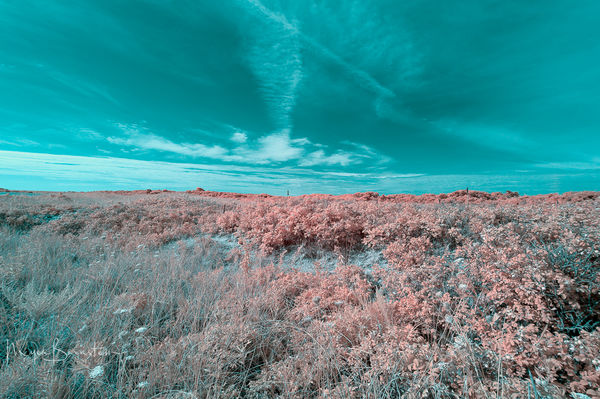
Aug 25, 2017 07:05:06 #
I bought a 590nm converted Olympus E-500 on eBay so cannot tell you who did the conversion but can attest to the choice being a good one in terms of infrared images. You can get nice color renditions or simply go to black & white. It's a learning curve in post production however so be prepared for that. Attached are a couple of samples.
Aug 25, 2017 07:09:49 #
sueyeisert
Loc: New Jersey
I've used Lifepixel and Kolarivision both are excellent. I think Kolarivision is faster and they have a coating that reduces hotspots. I have both supercolor 590 standard 720. I prefer 720 and don't use false color. Also Lightroom and photoshop can read the 720.
Aug 25, 2017 08:14:09 #
I HAD AN OLD CANON 20D DONE BY LIFE PIXEL, AND I LIKE THE IDEA OF NO FILTERS NEEDED. I CHOSE THE COLOR OPTION, BUT TRUTHFULLY, I MOSTLY MAKE MY IMAGES BW ANYWAY. IT OPERATES USING CHANNELS, WHICH GIVES YOU SOME CONTROL WITHIN THAT SETTINGS AREA. WORKS WELL AND WOULD PROBABLY GO THAT ROUTE AGAIN.
Aug 25, 2017 08:55:53 #
larryepage wrote:
I have seen a number of really wonderful IR photos... (show quote)
I use a Sony NEX-5 with the IR filter removed. I suppose that is much like what you call the Astronomical. Of course I often use a screw-on filter and in that way I can, at least in theory, mimic any one of the choices or for that matter a standard visual spectrum camera.
Visual + IR
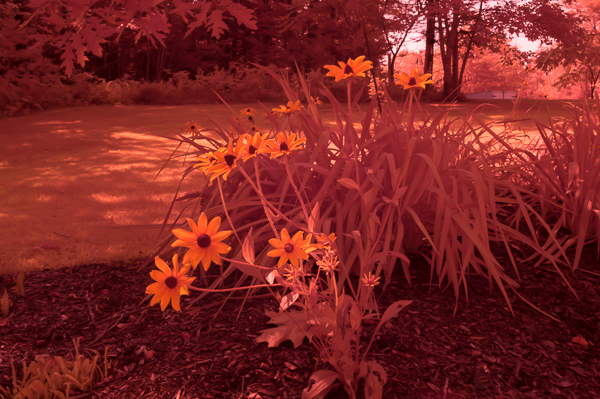
720 nm filter
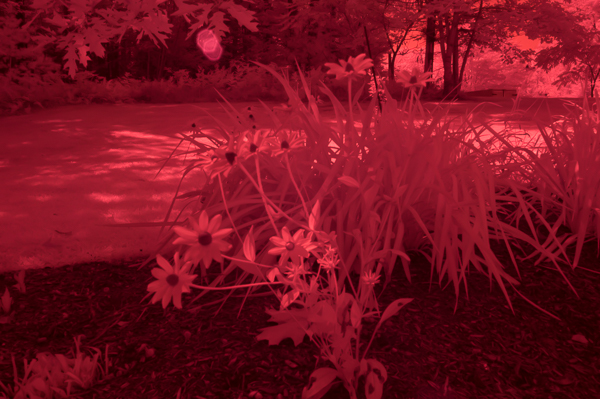
Blended and pp combination of above
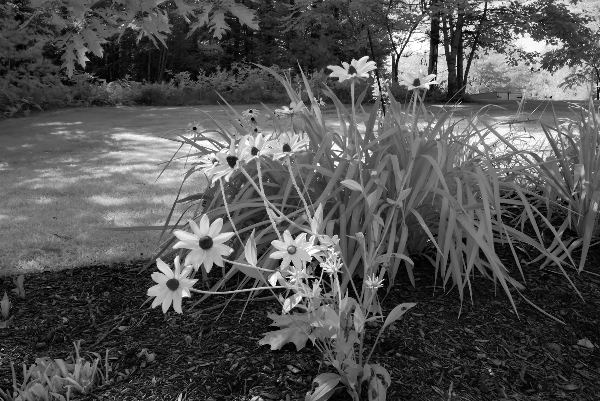
Aug 25, 2017 09:56:26 #
larryepage
Loc: North Texas area
Thank you for your kind and thoughtful replies and for the images. My initial thoughts were guided by the "traditional" view of IR photography...monochrome images shot through an IR filter. But your images show me that there is a real need to think about other options as well. I'm just not sure that my artist's eye is good enough to take advantages of the options that would come from a color IR system. As a retired practitioner of physics, mathematics, and engineering (Hello, pecohen), I'd love to have an extended response camera and look into astrophotography, but dark sky sites require many miles of travel from home.
Vince--Thanks for the links. I will take a look at those articles.
Pixelmaven--Your images are stunning. I'm not certain that I have the vision or patience to get results like that.
Sueviesert--It sounds like your process may be like what I am envisioning for myself. I'm wondering whether you considered the 830nm deep infrared option.
PictureThis--I believe that the 20D is a contemporary of the D200. Are you satisfied with the resolution and other functionality that you have? Resolution of the D200 is about 10 mp.
Pecohen--I really like what you have done with the two images. The broad spectrum + filters option certainly provides the most flexibility. It is not quite as convenient as having everything self-contained, though.
Also...I have the old Nikon 18-70 mm zoom that I bought 11 years ago when getting started in digital photography. It's not a great lens, but I notice that LifePixel will calibrate focus to it as one of their options, which leads me to believe that a lot of folks use it for IR. Do you have any shareable thoughts on lenses?
Vince--Thanks for the links. I will take a look at those articles.
Pixelmaven--Your images are stunning. I'm not certain that I have the vision or patience to get results like that.
Sueviesert--It sounds like your process may be like what I am envisioning for myself. I'm wondering whether you considered the 830nm deep infrared option.
PictureThis--I believe that the 20D is a contemporary of the D200. Are you satisfied with the resolution and other functionality that you have? Resolution of the D200 is about 10 mp.
Pecohen--I really like what you have done with the two images. The broad spectrum + filters option certainly provides the most flexibility. It is not quite as convenient as having everything self-contained, though.
Also...I have the old Nikon 18-70 mm zoom that I bought 11 years ago when getting started in digital photography. It's not a great lens, but I notice that LifePixel will calibrate focus to it as one of their options, which leads me to believe that a lot of folks use it for IR. Do you have any shareable thoughts on lenses?
Aug 25, 2017 10:35:54 #
I went with LifePixel to do a standard IR conversion of a Canon G11 p&s I had lying around. I was intrigued by infrared, and thought it would be a good addition for my travels through various early and ancient cultures (Maya ruins, old seaports, abandoned buildings, cemeteries, etc.). I was pleased with LifePixel's work (though I really have nothing to compare it with), and I'm glad I chose the "standard IR" conversion. It works especially well when photographing buildings, roads, and other man-made objects; the standard IR setting gives those photos an almost tin-type impression, while offering just enough of a white foliage, dark sky effect to stop the viewers eye. A photo of the abandoned fort on Dry Tortugas, Florida:
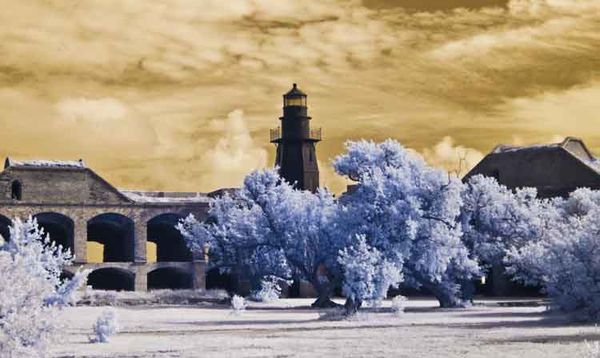
Aug 25, 2017 11:21:51 #
Aug 25, 2017 12:20:16 #
In addition to the choices of color sensitivity offered, another important factor relates to "hotspots". These can be caused by reflections between the sensor cover and the rear element of the lens; some lenses are more prone to this than others. Kolarivision offers an optional anti-reflection coating to subdue hotspotting with their conversions, and I recommend you take that step whoever does the work. I'm quite happy with my Kolarivision conversion, but like others have stated, I have no personal experience with other conversion houses. If I were having another camera converted, I would only have it done by someone offering the anti-hotspot option. For more about hotspotting, go here:
https://kolarivision.com/articles/lens-hotspot-list/
Good luck with your infrared adventures -- you'll be glad you did it!
https://kolarivision.com/articles/lens-hotspot-list/
Good luck with your infrared adventures -- you'll be glad you did it!
Aug 25, 2017 12:30:24 #
larryepage wrote:
I have seen a number of really wonderful IR photos... (show quote)
I had a camera converted by LifePixel with the enhanced color filter, because I knew I wanted to explore faux color IR. I have converted some to B&W also, and it works fine. I was very happy with LifePixel's service and support. Here are some examples of what I came up with. The second one has fill flash.
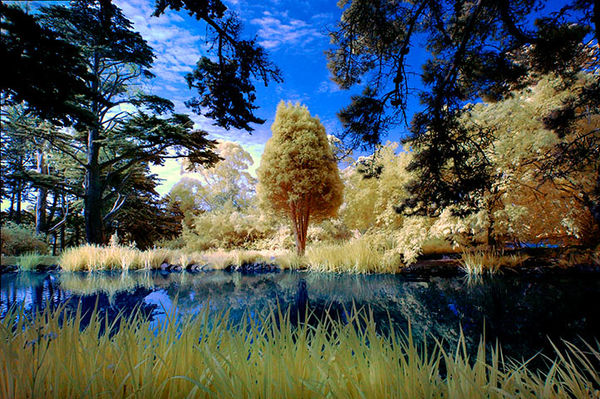
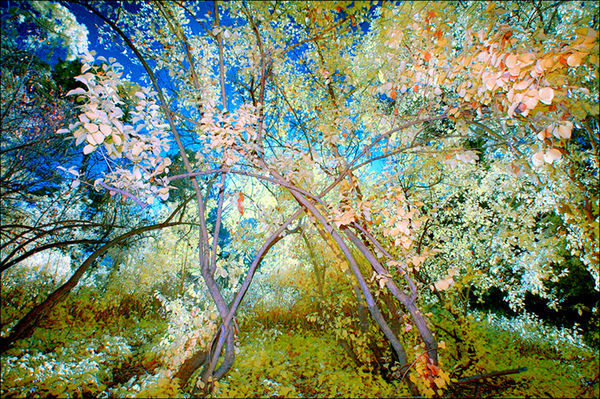
Aug 25, 2017 13:01:45 #
I used Kolarivision for my last conversion. From the date shipped until the package was delivered back to me, it was 10 working days. Great communication, honest and reasonable. I had a Nikon D750 converted to 720nm and it is a joy to use. When I engage Live View, I have full control of the aperture and can go to full open. On a previous camera that was converted (D700), the aperture would not fully open and the focus was never sharp. I advise against spending the money to convert an old camera if you can see your way to pick up a used D750. I really like the converted D750 and I feel that being a newer camera, it will last longer. Once the D200 goes down, you won't want to repair it. Good Luck! :)
Aug 25, 2017 13:59:23 #
larryepage
Loc: North Texas area
Strange--Thanks for your reply. The D200 has less than 20,000 clicks on the odometer, so I feel like it most likely has quite a bit of life left. Converting it would be a way to see whether my interest stays as high as it is right now. If so, then I could do something different, maybe with a different conversion. I agree, though, that the increased functionality of newer bodies is an important consideration. Even the D300 had significant operational improvements over the D200.
Frank--Thanks for your comments about hot spots.
John--In partnership with some of the earlier replies, you are causing me to have second thoughts about choosing between 720nm and color.
Frank--Thanks for your comments about hot spots.
John--In partnership with some of the earlier replies, you are causing me to have second thoughts about choosing between 720nm and color.
If you want to reply, then register here. Registration is free and your account is created instantly, so you can post right away.







